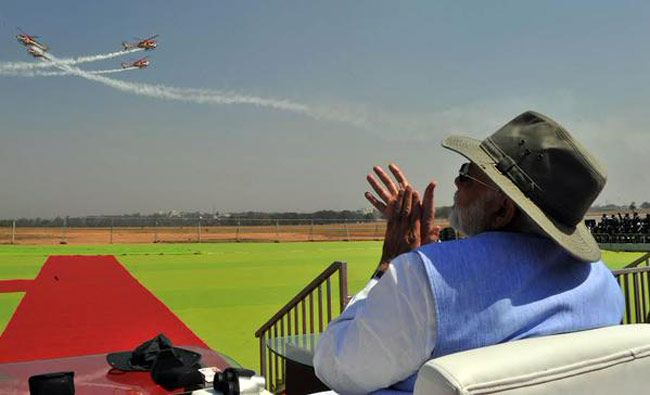The defence industry has received a major shot in the arm ever since Prime Minister Modi assumed power. The doing away of the bureaucratic red tape and the promotion of indigenous defence production under ‘Make in India’ is delivering rich rewards for the Indian military. The Indian Air Force has been severely deprived of modern fighter jets as the UPA government continued to ignore the IAF’s requests to upgrade its fleet of jets as the government’s sole focus was to loot public money from wherever possible.
Come 2019, India is slated to receive the first batch of Rafale fighter jets in May next year which will give India a huge strategic advantage and prepare itself for a two-front war which is a real possibility keeping in mind the antics of China and Pakistan. The Indian government has ordered 36 Raffles from the French company Dassault and will be customised to suit India’s needs. The government has also invited bids for 114 new medium multi-role combat aircraft (MMRCA) which has seen the major players in the aviation industry woo the Indian government with the likes of Saab, Lockheed Martin, Boeing and Dassault all aiming to win the contract and also manufacture the fighter jets under the ‘Make in India’ programme which will certainly lead to creation of thousands of jobs.
The Indian government has systematically improved the ease of doing business in the defence industry and has taken many steps to alter the status quo as the government introduced a new defence procurement policy (DPP) which was effective from 2016 and increased the Foreign Direct Investment in defence. As soon as the Modi government was sworn in, the FDI in the defence industry was increased to 49% from 26%. However, the FDI in 2015-16 was just about INR 56 lakhs thereby forcing the government to act allowing FDI up to 100% in some cases where the country would witness the latest technology transfer. Under the brand new DDP, a product will be required to have at least 40% indigenous content if it is designed in India or at least 60% indigenous content if the design is not indigenous, making it the most preferred category. India had the ignominy of having Defence Ministers like Mulayam Singh Yadav in the past who are best known for their caste-based politics and their only ideology is corruption. In an attempt to not let the day to day dealings of the Army to lie on the whims of a minister, Department of Industrial Policy and Promotion (DIPP) is constituted to exclusively issue licenses making it the final authority to issue licenses and not the Defence Minister.
Since the launch of Make in India, the government has allowed 56 manufacturing permits to private entities compared to 47 which were awarded in the preceding three years. This led to a direct decrease in the cost of defence procurement. The cost of defence procurement in 2014-15 stood at Rs.49,531 crore, down 9.96% from Rs.55,014 crore during 2013-14.
Additionally, the government has liberalized its licensing policy for the Indian manufacturers and also the initial validity of an industrial license has been increased from three years to 15 years with a provision to further extend it by three years on a case-by-case basis. The introduction of these reforms and policies has resulted in the growing market capitalization of some of the Indian defence companies that have grown at a staggering outperforming Compound Annual Growth Rate (CAGR) of 34% outperforming even Nifty (=9.4%) during that period. The biggest gainer being Zen technologies which recorded a profit of 330.22% after tax and saw a market capitalization of 73.04%. On an average from 2014-17, defence companies listed in India showed a profit of 29.73% after tax and a market capitalization of 34.13%.
The slew of reforms initiated by the Modi government has made India an extremely attractive market as the major defence players queue up to win the contract to supply fighter jets to India. While Dassault Aviation was successful in piping its competitors to land the contract to supply Rafales to India, the likes of Saab and Lockheed Martin are also trying to woo the government.
Saab wants to offer its Gripen to India at half of Rafale cost, with full tech transfer and local production which must be music to government’s ears. However, India has conveyed its displeasure to Saab as the latter also provided the early warning aircraft system to Pakistan and doesn’t want to do business with any company which also arms its enemy which has prompted Saab to not sell any new products to Pakistan.
Lockheed Martin in a Joint Venture with Tata Advanced Systems have already set up a plant in Hyderabad where they will produce the wings of the new-age F-16s which will be later exported to the rest of the world and the plant already employs over 1,000 people. The company has also submitted a proposal evincing preliminary interest to supply F-21 fighter jets to the Air Force and winning the bid may result in it working with 400 local companies as the company has already identified 400 odd companies as the aircraft manufacturers depend on a lot of vendors to supply components creating an entire downstream ecosystem.
It is no coincidence that the major players in the defence industry are looking to enter India and willing to lower the costs of their jets and also agree to manufacture in India. The transfer of technology will also help India in building its indigenous fighter jets as the country looks to procure 114 new MMRCA as it aims to beef up its Air Force which would make China and Pakistan think twice before resorting to any misadventure.
